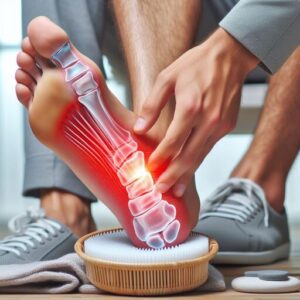Ultimate Resource for Understanding Plantar Fasciitis: Causes and Proven Treatment Methods
Plantar Fasciitis Explained: A Detailed Look at This Common Foot Condition
Plantar fasciitis is one of the most prevalent foot ailments impacting millions of people worldwide, often resulting in severe discomfort that can hinder daily activities. This condition predominantly affects active individuals aged 25 to 65, where it typically presents as chronic heel pain. The issue arises when the plantar fascia, a robust band of connective tissue situated at the foot’s sole supporting the arch, becomes overstretched or injured. Factors contributing to this strain include high levels of physical exertion or prolonged periods spent standing, which can diminish the elasticity and durability of the plantar fascia. This leads to inflammation and sharp pain, especially around the heel area. Gaining a comprehensive understanding of plantar fasciitis is vital for those seeking effective relief and treatment solutions, as it can significantly enhance their ability to participate in daily activities without discomfort.
Accurate Diagnosis: Essential Procedures for Identifying Plantar Fasciitis
Comprehensive Steps to Achieve an Accurate Diagnosis of Plantar Fasciitis
<pReceiving a definitive diagnosis for plantar fasciitis generally requires an in-depth physical examination by a qualified healthcare provider. During this thorough assessment, the clinician will inquire about your specific symptoms and analyze your feet for any visible indicators of distress. They may apply gentle pressure to your plantar fascia to evaluate inflammation and accurately assess your pain response. It’s crucial to detail your daily discomfort experiences, particularly noting when and where the pain is most pronounced throughout your day. In many instances, plantar fasciitis can be diagnosed clinically without the need for extensive testing. However, if your physician suspects other underlying issues, they may suggest imaging procedures, such as X-rays, to exclude other potential sources of your foot pain.

Identifying the Main Symptoms Linked to Plantar Fasciitis
The symptoms associated with plantar fasciitis may either develop gradually or appear abruptly, particularly following intense physical activity. Early identification of these symptoms is crucial for prompt intervention and effective treatment. The severity and duration of symptoms can differ significantly among individuals. The hallmark symptom is localized pain in the foot’s sole near the heel, which can manifest as a dull ache or a sharp, stabbing sensation. Additionally, discomfort may occur in the arch of the foot, often described as a burning feeling. Many individuals report experiencing significant pain upon rising or after long periods of inactivity, frequently accompanied by stiffness that typically resolves after a few minutes of movement. Other prevalent symptoms include increased pain after engaging in physical activities, tenderness when pressure is applied to the affected area, and noticeable foot stiffness, especially after sleeping or sitting for extended intervals.
Diving Deep into the Causes Behind Plantar Fasciitis
Plantar fasciitis occurs when the plantar fascia, a thick band of tissue located on the foot’s underside, is overstretched or subjected to excessive strain due to repetitive activities, such as prolonged standing or running. This condition can also be associated with sudden weight gain, often experienced during pregnancy. The constant tension on the plantar fascia can lead to chronic degeneration or micro-tears in the fascial fibers, especially at the point where the fascia attaches to the calcaneus or heel bone. These micro-tears result in inflammation and pain, profoundly impacting mobility and daily life. Diagnostic imaging methods, such as ultrasonography, can reveal thickening and calcification of the plantar fascia, highlighting more severe manifestations of this painful condition.
Understanding the Specific Risk Factors That Elevate Your Chances of Plantar Fasciitis
- Foot arch abnormalities, including both flat and high arches
- Long-distance runners or individuals who frequently jog on downhill or uneven surfaces
- Being overweight or experiencing rapid weight gain
- A tight or stretched Achilles tendon
- Wearing shoes that lack adequate arch support or have soft soles
- Sudden changes in physical activity levels or intensity
Crucial Steps to Secure an Accurate Diagnosis for Plantar Fasciitis
If you suspect that you are suffering from plantar fasciitis or are experiencing persistent foot pain, it is imperative to consult your healthcare provider for an accurate diagnosis and a tailored treatment plan. Early intervention can substantially enhance your comfort levels and improve your overall quality of life. Your doctor will perform a thorough examination of your foot, searching for specific symptoms or risk factors associated with plantar fasciitis. They will assess any areas of increased tenderness beneath the heel bone, evaluate your foot arch type, and check for limited dorsiflexion, which is the upward movement of the ankle.
Alongside a thorough physical examination of your foot, your doctor may recommend X-rays or ultrasound imaging if other injuries or conditions, such as heel spurs or arthritis, are suspected. These imaging techniques can help visualize the plantar fascia, revealing signs of thickening or inflammation that are common indicators of this condition. Should conservative treatment options fail to alleviate your discomfort, your doctor may suggest more advanced imaging techniques like magnetic resonance imaging (MRI) to rule out other potential complications.
Exploring Effective Treatment Options for Plantar Fasciitis Relief
Most individuals grappling with plantar fasciitis can expect to see recovery within nine to twelve months after beginning non-surgical treatment approaches. It is important to understand that the effectiveness of these treatments may vary based on the individual’s specific condition and adherence to the prescribed regimen.
Common Non-Surgical Treatment Approaches Include:
Rest. The first and most essential step in managing plantar fasciitis is to take a break from activities that aggravate the pain. Giving the plantar fascia time to heal is crucial. During this recovery phase, consider engaging in low-impact activities like cycling or swimming, which apply significantly less stress on your feet compared to walking or running.
Ice. Using ice on the affected area can effectively reduce inflammation and alleviate pain. Apply a cold water bottle or ice pack to the painful area for 15 to 20 minutes three times daily, especially after activities that exacerbate your pain, providing substantial relief.
Stretching. Tightness in the foot and calf muscles can exacerbate the symptoms of plantar fasciitis. Integrating targeted stretching exercises into your daily regimen can help lengthen these muscles, thereby relieving strain on the plantar fascia.
Night splints. Wearing night splints can gently stretch the plantar fascia during sleep, preventing the tissue from tightening overnight and minimizing morning stiffness and discomfort. While it may take time to adjust to wearing a splint, many individuals experience significant relief from heel pain as a result.
Footwear choices. Selecting supportive shoes that offer ample cushioning and arch support is vital for managing plantar fasciitis pain. Steer clear of shoes that lack proper support or are excessively worn. If your discomfort persists, consult your doctor regarding custom orthotics, which can provide additional support tailored to your foot’s specific requirements.
Physical therapy. Your healthcare provider may recommend a structured exercise program with a physiotherapist. This program would focus on stretching the calf muscles and implementing specific plantar fascia therapy. Furthermore, physical therapy may include cold treatments, massage, and other therapeutic modalities aimed at reducing inflammation in the plantar fascia.
Nonsteroidal anti-inflammatory medications (NSAIDs). Over-the-counter NSAIDs, such as ibuprofen, can assist in relieving pain and inflammation. However, it is crucial to use these medications under the guidance of a healthcare professional and for a limited duration to avoid potential side effects.
If Conservative Treatments Fail to Provide Adequate Relief, Your Doctor May Suggest:
A walking boot and crutches. These assistive devices may be prescribed for a limited duration to ensure proper rest for your foot.
Corticosteroid injections. For severe pain and inflammation that do not respond to conservative treatments, corticosteroid injections may be utilized. While these injections can provide temporary relief, they are typically administered cautiously due to the risk of weakening the plantar fascia and potential complications.
Extracorporeal shockwave therapy (ESWT) is another non-invasive treatment option that delivers high-energy shock waves aimed at promoting healing in the plantar fascia. However, this treatment may not be suitable for everyone.
Botulinum toxin injections utilize a protein derived from the bacteria Clostridium botulinum. These injections can help relax the tissue surrounding the plantar fascia, thereby alleviating pain.
Dry needling is a technique that employs a sterilized needle to stimulate myofascial trigger points in the affected area. While the effectiveness of dry needling for plantar fasciitis remains a subject of debate, some studies suggest it may help diminish pain severity.
Low-level laser therapy. Your healthcare provider may consider this option to alleviate pain and inflammation associated with plantar fasciitis. Research indicates that this therapy can provide relief from heel pain for several months.
Foot surgery is viewed as a last resort for those who do not respond to non-surgical treatment options. Although surgical intervention can offer relief, it carries inherent risks and the potential for chronic pain.

Choosing the Right Footwear to Effectively Manage Plantar Fasciitis
Selecting appropriate footwear is critical for effectively managing plantar fasciitis. Wearing suitable shoes can greatly reduce the risk of developing or worsening this painful condition.
When searching for shoes that are beneficial for plantar fasciitis, consider the following essential characteristics:
Arch support. Proper arch support is crucial as it helps distribute weight evenly across the foot, thereby reducing pressure on the plantar fascia and minimizing discomfort during physical activity.
Cushioning. Shoes with ample cushioning in the arch and forefoot areas help absorb shock and lessen strain on the plantar fascia, ensuring greater comfort with each step.
Heel support. Look for shoes with a firm heel counter, as the heel experiences significant impact during movement, which can lead to microtrauma to the fascia. Soft silicone heel cushions can provide additional support and comfort.
Shock absorption. Choose footwear that boasts excellent shock-absorbing properties, particularly in the heel area. Cushioned soles or gel insoles can enhance shock absorption, further protecting the plantar fascia from injury.
Consult with a podiatrist or orthopedic specialist for recommendations tailored to your unique foot structure and the severity of your plantar fasciitis. Additionally, consider custom-made or over-the-counter orthotic inserts, which can help evenly distribute pressure across your feet, alleviating pain and discomfort.
Incorporating Targeted Stretching Exercises to Alleviate Plantar Fasciitis Symptoms
Research indicates that specific stretching exercises aimed at plantar fasciitis can significantly contribute to pain relief as part of a comprehensive treatment strategy. Notably, a study showed that participants who engaged in consistent stretching routines over eight weeks experienced a remarkable 52% reduction in heel discomfort. Maintaining flexibility in the calf muscles is vital for preventing the onset of plantar fasciitis.
To optimize your stretching routine, strive to perform these exercises three times daily: in the morning, before lunch, and before bedtime.
Calf stretch. Stand facing a wall, keeping one leg straight behind you with the heel flat on the ground. Bend the other knee and lean forward, pushing your hips toward the wall. You should feel a stretch in the calf of the straight leg. Hold this position for 15 to 30 seconds, then switch legs.
Plantar fascia stretch. While seated, place one foot flat on the floor. Lift your other leg and position your ankle across your knee in a figure-four posture. Grasp the toes of the elevated foot and gently pull them back towards you, feeling a stretch in the sole of your foot. Use your other hand to gently massage the stretched area. Hold for 10 seconds and repeat this stretch ten times on each foot.
It’s crucial to remember that while these exercises can be beneficial, they should not replace professional medical advice from your healthcare provider or other qualified practitioners. Always consult your doctor for personalized guidance and treatment options.
The post Plantar Fasciitis – Identifying Effective Treatments appeared first on MCR Therapies.
The Article Plantar Fasciitis: Discovering Effective Treatment Options appeared first on https://mcrtherapies.com
The Article Plantar Fasciitis Treatment: Explore Effective Solutions Was Found On https://limitsofstrategy.com


Comments are closed